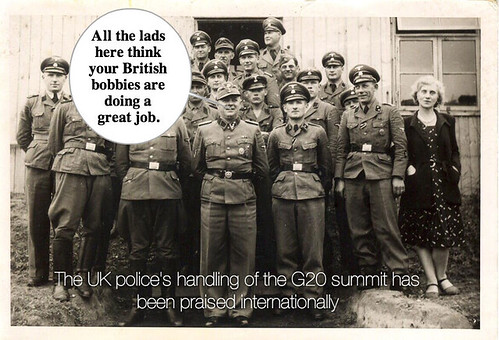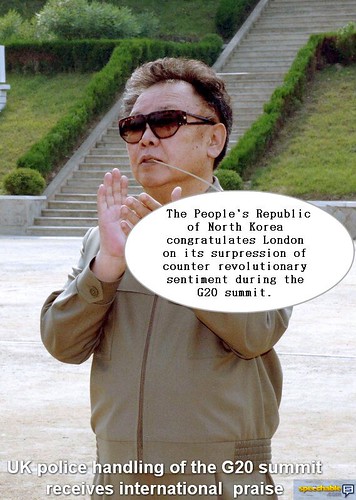
UK policing tactics at G20 summit garner international praise, originally uploaded by Teacher Dude's BBQ.
Met chief: G20 police deserve praise despite Tomlinson death
Sir Paul Stephenson says death of passerby is disturbing but crowd 'containment' tactics have received international acclaim
The commissioner of the Metropolitan police went on the offensive today, defending his officers for an "astonishing" police operation during the G20 that he said had received international praise.
Sir Paul Stephenson said his comments were made in the context of a man having died during the demonstration, and of footage that was deeply concerning. But he went out of his way to praise what he said were an overwhelming majority of officers who carried out a professional job on the day.
Picking out the territorial support group (TSG) – which is at the centre of two IPCC investigations into Ian Tomlinson's death and an assault on a woman protester – Stephenson said it was a specialist unit the Met relied on.
"These and others are our first line response to some of the most difficult and challenging situations," he said.
The commissioner, who has spoken personally to TSG officers in a bid to raise their morale, said all knew they were individually accountable for their actions.
He said officers who were found to have deliberately hidden their numbers would be severely disciplined. "If someone is trying to deliberately avoid being identified and their reason is so they can behave inappropriately, criminally, then of course they could face the sack," Stephenson said.
He planned to tackle the problem of police identification by examining whether every officer should wear name tags.
The commissioner said there were supervision problems with some groups of officers and he wanted this improved. "The overwhelming majority did [wear their numbers]. There is not sufficient concentration on intrusive supervision.
"That is what I believe in. It is the job of supervisors to go and find out how good your people are so that you can say well done and sometimes to find out where they are going wrong."
The commissioner spoke as a pathologist was carrying out the third postmortem on Ian Tomlinson's body. It was done at the request of lawyers for the TSG officer seen in footage obtained by the Guardian apparently attacking Tomlinson. The Met will be present at the postmortem after receiving advice from its lawyers.
The IPCC is investigating the circumstances of Tomlinson's death; a second incident in which a TSG sergeant is seen hitting a woman protester; and a third case that resulted from another complaint from a protester about police violence.
Stephenson has asked for a review of all footage in the Met's possession. This is being carried out by the Met's department of professional standards. Denis O'Connor, Her Majesty's inspector of constabulary, has been asked to examine the tactics used by the Met for public order events, specifically the issue of containing demonstrators for several hours.
Stephenson said the use of containment had begun after a demonstration in June 1999 when protesters caused £13m worth of damage. "The policy of containment has come from our history. As a consequence of this we … developed a policy of graduated control which at some point may involve containment. If there is a better way to do it we are up for learning it, but we don't know of a way."
Stephenson said he had received acknowledgment from police forces internationally for what the Met achieved during the G20.
"Part of the headlines should be … astonishing operation pulled off by the Met who did a first-class job," he said.
"The overwhelming majority of officers, whatever the stress or provocation, carried out their duties in a professional manner and I want to give them credit for what they achieved." He said his comments were in the context that some of the footage he had seen caused him deep concern, and the Met was cooperating with the IPCC to help provide the answers that Tomlinson's family wanted.
Stephenson said the Met had never misled anyone in the aftermath of Tomlinson's death. He said the scene where he collapsed was secured, sealed off and treated as a crime scene and the press statement the Met released in the aftermath of the death was approved by the Independent Police Complaints Commission.

No comments:
Post a Comment